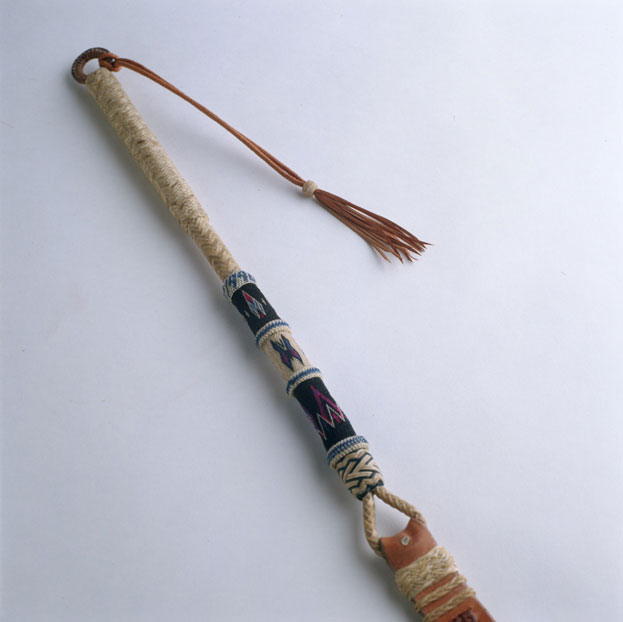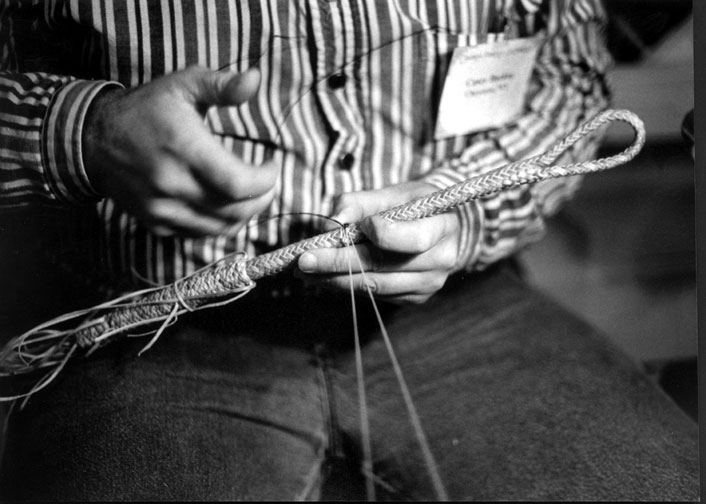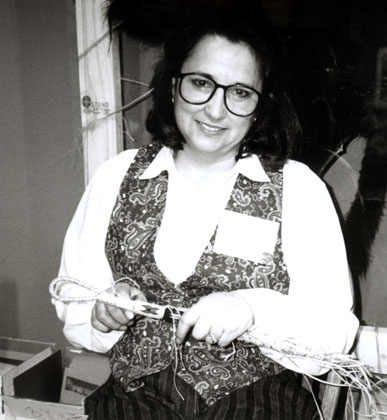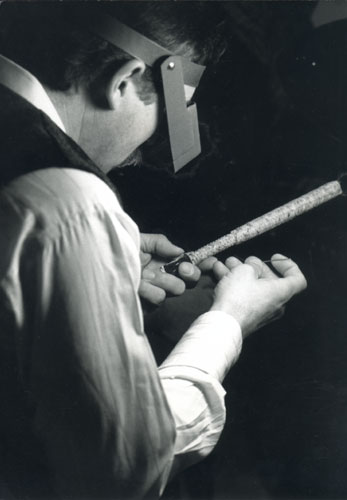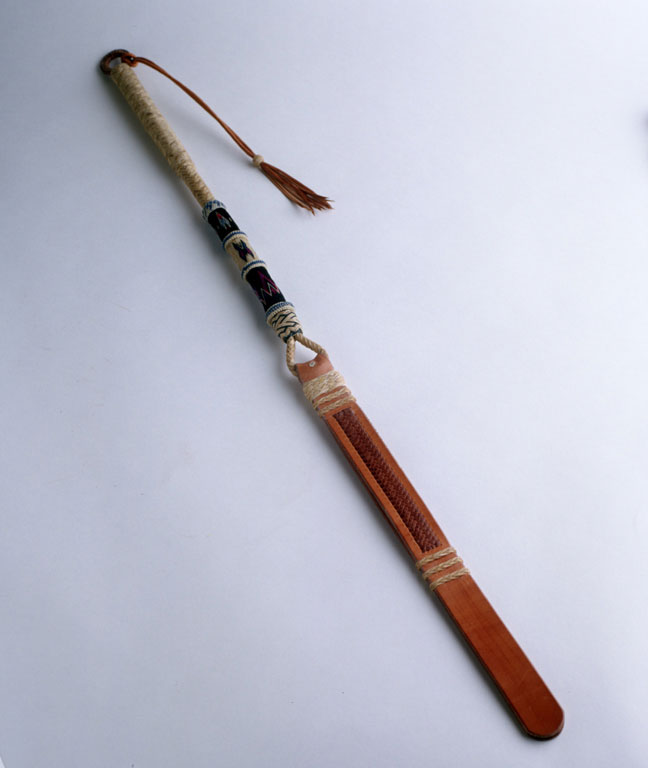Tools of the Trade: Braided, Twisted and Tied / Horsehair Artists
The following horsehair artists are represented in the Western Folklife Center Contemporary Gear Collection.
Group Quirt – Multiple Artists
Conceived by Casey Backus, this quirt was made at the 1998 Cowboy Poetry Gathering by a number of artists participating in our Braided, Twisted and Tied exhibit and donated to the Western Folklife Center. Artists contributing their work to this quirt include Mike Beaver of Hayden, Idaho (main braided rawhide body); Randy Stowell of Hagerman, Idaho (braided handle and ring); and Nate Wald of Lodge Grass, Montana (wrist strap). Horsehair hitching is by Casey Backus of Cheyenne, Wyoming; Toni Schutte of Tonopah, Nevada; Doug Krause of Eaton, Colorado; and Gary Stark of Nampa, Idaho. The rawhide knots were contributed by Sharon Paulin of Pine Valley, California and Scott Sayers of Three Forks, Montana. The appliqué braided popper was made by Ray Huffman of Amesville, Ohio.
Photos of Casey Bachus, Toni Schutte, Gary Stark and Randy Stowell by Carol Edison.
Alfredo Campos – Hitched Horsehair Quirt, Federal Way, Washington
Alfredo Campos grew up on his family's ranch near Tucson, Arizona, and was first drawn to making horse gear with rawhide. Years later, after a move to the Pacific Northwest to find work at Boeing, he became aware of horsehair hitching, teaching himself this complex art form by trial and error, through the study of historic prison pieces, and by referring to Eugene Barnett's book, The Art of Horsehair Hitching. In 1984 an article about Alfredo and his hitching appeared in Western Horseman magazine and sparked an increased interest in this art form. Alfredo continues to lead the revival of horsehair hitching, with his eye for excellence inspiring many artists. In 1999, Alfredo received national recognition for his work through a National Heritage Fellowship from the National Endowment for the Arts. Alfredo has seven years of orders on his list.
Alfredo Campos
Photo by Brent Herridge
Photo by Brent Herridge
Helen Dougal – Mecate, Jordan Valley, Oregon
Ingenuity, self-sufficiency, and creativity are qualities that come to mind when describing the Dougal family of Jordan Valley. Helen is the third generation of women in her family to create horsehair ropes (mecates). Her mother, Frankie Dougal, was Helen's teacher, starting her first with the picking (separating) of hair and turning the mecate twister; and at age ten Helen made her first rope. Helen comments that she especially likes mixing the natural colors of horsehair; no two ropes are ever alike. "It's amazing how sorrel, black, white, and grey can all be so different." Helen also laments that mecate making has become a very expensive hobby due to the lack of easy access to mane hair. "Today, with all the controls and bans from different groups of people in the U.S., we are not allowed to even use our own natural resources," she says. She has to buy mane hair from abroad and pay $10/pound plus shipping to continue a long-time family tradition.
Photo by Kevin Martini Fuller
Photo by Michael Houghton
Photo by Kevin Martini Fuller
Photo by Brent Herridge
Frankie Dougal – Mecate, Jordan Valley, Oregon
This hackamore rope made by Frankie Dougal is 22' x 5/8'' and made of grey, sorrel, black, and white mane hair. Frankie spent her life living and working on the family's remote ranch in southeast Idaho's Owyhee County, just over the Oregon border. The making of mecates (horsehair ropes) was taught to Frankie at the age of nine by her mother, who in turn learned it from a vaquero on their home place, the 5 Bar Ranch on the Owyhee River. The tools her mother used are still on the ranch, as well as innovative and time saving devices made by Frankie's late husband, Chuck, who was known for his spur making. Frankie confessed once that she had dreamed of a career as a hair beautician. Instead, she made a name for herself working with horsehair. Her beautifully made ropes are sought after by working cowboys and collectors all over the world. Frankie passed on her knowledge to her daughters; Helen makes mecates and Charlene makes horsehair cinches, headstalls, and other leatherwork.
Kelly Kinkade – Headstall, Reins & Romal, Bozeman, Montana
Kelly Kincade first participated in the Western Folklife Center's Gathering of Gear exhibition in 1994. Kelly's contribution was this complete hitched headstall with reins and romal made up of a 6-hair pull (strand made by twisting 6 hairs together). Hours of work, much patience, and concentration are characteristics shared by all horsehair hitchers. Elaborate hitched pieces such as this are historically associated with prisons such as the Montana State Prison, and facilities in Yuma, Arizona, Rawlins, Wyoming, and Walla Walla, Washington, which provided training and supplies. Hitched horsehair is still being produced and sold from prisons in the West, but the art form has also seen a revival among gearmakers throughout the region.
Photo by Michael Houghton
Photo by Brent Herridge
Photo by Meg Glaser
Photo by Brent Herridge
Doug Krause – Mecate, Eaton, Colorado
Horses are always nearby Doug Krause's workshop in Eaton, Colorado. He believes that without the effort to become a better horseman, he would not have the understanding, feel and knowledge to build equipment of the quality and function valued by horsemen. The interior of his workshop is designed to accommodate a number of Doug's skills - mecate making, horsehair hitching, saddlemaking, and braiding - each with their own set of tools. Doug has been braiding since 1972, hitching since 1978, and making mecates since 1995. Doug believes building horse gear is an evolution, a kind of journey. His mecates are very traditional in style, but their construction has been made more efficient in recent years with the use of innovative tools once used by a rope maker named Blind Sam. Doug received the "Best of Show" award in the Western Folklife Center's Gathering of Gear show in 1998, and was designated the Hitcher and Braider of the Year in 2001 by the Academy of Western Artists.
Larry Schutte – Human Hair Mecate, Tonopah, Nevada
The hair required to create this human hair rope took Larry Schutte a few years to gather. Fortunately Larry's wife Toni was working in a hair salon at the time. Larry and Toni have a spiritual and artful approach to their chosen life of horseback work. Larry learned to make horsehair mecates from Bill Kane while working on the Spanish Ranch in northeastern Nevada. His cow and horse savvy have brought him jobs throughout northern Nevada and his skills as a braider and mecate maker are known across the region. Larry and his wife Toni currently live and work on a ranch outside of Tonopah, Nevada.
Photo by Blanton Owen
Photo by Michael Houghton


